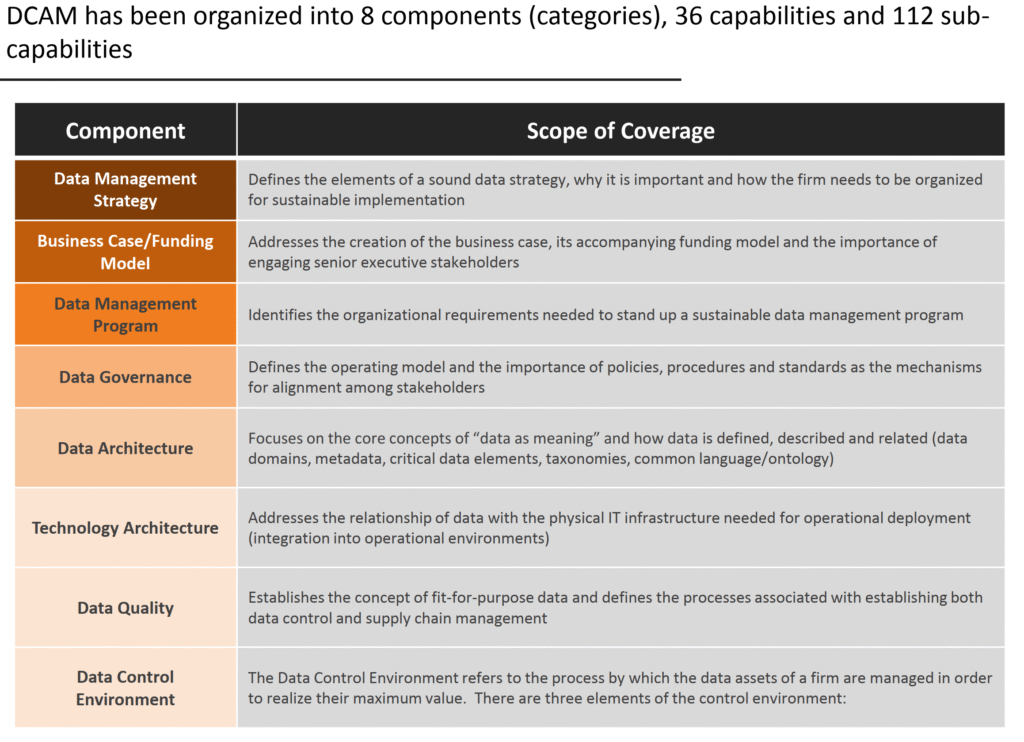
Status: Final Blueprint
Author: Shahab Al Yamin Chawdhury
Organization: Principal Architect & Consultancy Group
Version: 1.0
Date: July 26, 2024
1. The Strategic Imperative
In the modern digital economy, data is a primary strategic asset. The ability to manage, govern, and leverage this asset determines competitive advantage, operational efficiency, and regulatory compliance. The Data Management Capability Assessment Model (DCAM), developed by the EDM Association, is the global standard framework for this purpose. It provides a structured, objective path for enterprises to establish, mature, and sustain a robust data management function, transforming data from a liability into a high-value asset. A mature data capability is no longer just a compliance task; it is a fundamental enabler of innovation and a critical de-risking mechanism for strategic initiatives like AI and cloud adoption.
2. DCAM v3 Framework Architecture
The framework is a logical hierarchy designed for both strategic overview and granular assessment.
- 8 Core Components: The essential pillars of a comprehensive data management program.
- Data Strategy & Business Case: Aligns data management with business objectives and value.
- Data Management Program & Funding: Establishes the operational structure, roles, and funding.
- Architecture (Business, Data & Technology): Ensures data is engineered to support business needs.
- Business Data Knowledge: Manages business glossaries and metadata to foster data literacy.
- Data Quality Management: Measures, monitors, and remediates data quality issues.
- Data Governance: Provides the operating model, policies, and control framework.
- Data Management Operations, Risk & Control: Operationalizes governance within a risk control environment.
- Analytics Management: Governs the analytics lifecycle to deliver trusted insights and AI.
- 34 Capabilities: Defines what an organization must do within each component.
- 101 Sub-capabilities: Provides the granular, evidence-based criteria for assessment.
3. Comparative Framework Analysis
DCAM’s unique value is its focus on actionable assessment and roadmapping, complementing other industry models.
| Feature | DCAM v3 (EDM Association) | DAMA-DMBOK2 | Gartner EIM Maturity Model |
| Primary Goal | Assess, benchmark, and roadmap improvement. | Provide a comprehensive “Body of Knowledge.” | Provide a high-level strategic maturity model. |
| Approach | Prescriptive & Evaluative (“How well?”). | Descriptive & Encyclopedic (“What is it?”). | Conceptual & Strategic (“Where are we?”). |
| Ideal Use Case | Baseline assessments, building roadmaps, regulatory prep. | Education, defining roles, establishing a new function. | Executive communication, strategic vision setting. |
4. The DCAM Scoring Matrix
Each of the 101 sub-capabilities is scored on a 6-level scale, providing objective and repeatable measurement.
| Score | Level Name | Description | Key Characteristics |
| 1 | Not Initiated | Activities are ad-hoc, informal, and reactive. | No formal process; work done by “heroes.” |
| 2 | Conceptual | The need is recognized; initial planning stages. | Capability is being discussed; no formal commitment. |
| 3 | Developmental | A formal project is funded and underway. | Project charter exists; capability not yet operational. |
| 4 | Defined | Capability is formally defined, documented, and approved. | Documentation is signed-off; governance is active. |
| 5 | Achieved | Fully operational and adopted as business-as-usual (BAU). | Embedded in workflows; enforceable and auditable. |
| 6 | Enhanced | Embedded in culture; subject to continuous improvement. | Integrated and optimized; benchmarked against leaders. |
5. From Assessment to Actionable Strategy
A DCAM assessment is the start of a transformation journey, not the end.
- Conduct Assessment: Use workshops and interviews to gather evidence and build consensus on current-state scores for each sub-capability.
- Visualize & Analyze: Use radar charts to compare current state, target state, and industry benchmarks. This highlights the most critical gaps and creates urgency for executive action.
- Build a Roadmap: Develop a prioritized, multi-year roadmap focusing on foundational capabilities first, then scaling and optimizing. Identify “quick wins” to build momentum.
- Quantify ROI: Create a business case that models investment costs against financial gains (e.g., operational efficiency, risk reduction, increased revenue) to justify and sustain funding.
6. Conclusion: The Foundation for the Future
DCAM is the indispensable framework for any organization serious about leveraging data as a strategic asset. It provides:
- A common language to break down silos between business, IT, and compliance.
- An objective, evidence-based method to measure maturity and benchmark against peers.
- A clear path to building the trusted data foundation required for responsible AI and modern architectures like Data Mesh.
By adopting DCAM, organizations move beyond reactive data firefighting to build a sustainable, value-driven data management capability that serves as a cornerstone of competitive advantage and future innovation.